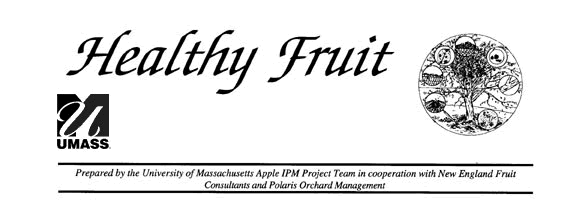
|
|
|---|
We have calculated the possible infection periods for the Horticultural Research Center in Belchertown, MA since the April 9 green tip date. We hope this information will be very useful for orchards in and near Belchertown. For those of you further away, if you can gauge the relative differences in temperature and wetness between your site and the HRC, it should still be useful. Wetting periods (rain) occurred on 4/9, 4/16, 4/17, 4/22, and 4/23. The good news, though, is that the first four periods were sufficiently cold to keep them from being infection periods. That means they don't even register on the Mill's table on page 8 of the 1998-1999 New England Apple Pest Management Guide. The most recent wetting period, on 4/23, however, registered in the low to moderate infection severity range.
The Belchertown orchard has accumulated 224 degree-days since green tip. That places it at about 10% scab ascospore maturity and indicates that the scab is still in the early phase of development (see Figure 1 on page 9 of the guide). This means that blocks which had little or no scab problems last year are still in good shape with a conservative management approach, and that blocks which had problems last year will need a more aggressive approach during the current primary scab season. If you are sure that scab inoculum is low (that is, below a PAD of 50) then there has been no reason to spray yet. However, if you are not sure, or feel that inoculum was in or near the orchard from last year's scab, then it would have been necessary to treat the last infection period.
Over the past few weeks, tarnished plant bugs have had a scattering of good days for activity. However, captures of TPB adults on sticky, white monitoring traps remain as low as any year in memory. In fact, of 15 orchards monitored for TPB activity at tight cluster, none have exceeded the recommended treatment thresholds, which are as follows:
|
Cumulative TPB per trap |
||
|
Market |
(Silvertip to Tight Cluster) |
(Silvertip to Pink) |
|
Wholesale |
3 |
5 |
|
Retail |
5 |
8 |
Though TPB activity has been light thus far, which falls in line with the trend of the last 4 or 5 years, growers may see spikes in activity through bloom, given a few consecutive days with warm temperatures. If TPB trap captures do warrant a pre-bloom treatment, Guthion, Imidan, and Lorsban remain the materials of choice.
In stark contrast to TPB, leafminer adults have exhibited a high level of activity. This abundance of LM has developed despite relatively cool, windy weather conditions that generally delay LM population growth and egglaying. In 12 monitored orchards (at or near tight cluster), 10 have exceeded the following treatment thresholds, based on captures of ABLM adults on sticky red trunk traps. Aggressive LM egglaying has already been observed in a few orchards at tight cluster.
|
Cumulative ABLM per trap* |
||
|
Cultivar |
(Silvertip to Tight Cluster) |
(Silvertip to Pink) |
|
McIntosh |
4 |
9 |
|
non-McIntosh |
8 |
21 |
|
*The effectiveness of trunk traps for monitoring STLM is not currently known. |
||
To expand upon last week's treatment options, there are many ways to approach LM management. Pre-bloom application of a pyrethroid (Asana, Ambush, or Pounce), Vydate, or Thiodan is the most immediate option; growers may choose to use one of these materials early, taking a known risk of mite predator suppression or, in the case of Thiodan, sketchy LM control. Along with the negative chemical impacts of these materials, effective control from a pre-bloom treatment can be difficult, as LM adult emergence and egglaying may be strung out over a long period.
Treatments used against the first summer generation (soon after petal fall) may be the most effective, with Provado and AgiMek the materials of choice. SpinTor is also labeled for use, but it remains to be seen whether this material can yield lasting control. More detailed information regarding the effectiveness of this and other post-bloom materials is available in the 1998 and 1999 issues of the March Message and will be laid out in forthcoming issues of Healthy Fruit.
No hatch of European red mite eggs has been observed thus far, so growers may still be able to capitalize on the effectiveness of oil applications if the weather is agreeable. As stated in previous issues of Healthy Fruit, oil applied through mid-pink will have a beneficial effect on season-long mite management by delaying the mite population's potential for reaching damaging levels.
We strongly discourage use of either Savey or Apollo in back-to-back seasons, as resistance develops to both through a similar mechanism. Use of either in sequence will likely result in resistance to both. Thresholds for early-season treatment based on abundance of ERM eggs (developed in Nova Scotia) will be addressed in next week's issue.
Pear psylla eggs have begun to hatch, and nymphs have been observed feeding on developing pear bud clusters. Given that egg hatch has begun, the effectiveness of oil on psylla has decreased; oil may marginally deter feeding for a brief period, but loses its ability to smother hatching eggs.
Healthy Fruit is written by Dan Cooley, Ron Prokopy, Starker Wright, Wes Autio, and Duane Greene except where other contributors are noted. Edited by Dan Cooley. Publication is funded in part by the UMass Extension Agroecology Program, grower subscriptions, and the University of Massachusetts IPM Program. A text version can be e-mailed to you if you contact Doreen York. Please cite this source if reprinting information.